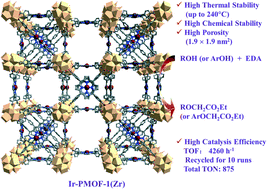Self-assembly of a new metalloporphyrin tetracarboxylic ligand Ir(TCPP)Cl (TCPP = tetrakis(4-carboxyphenyl)porphyrin) with ZrCl4 in the presence of benzoic acid leads to the formation of a three-dimensional (3D) iridium(III)-porphyrin metal–organic framework (Ir-PMOF) with the formula of [(Zr6(μ3-O)8(OH)2(H2O)10)2(Ir(TCPP)Cl)3]·solvents (Ir-PMOF-1(Zr)), which possesses square-shaped channels of 1.9 × 1.9 nm2 (atom-to-atom distances across opposite Ir metal atoms) in three orthogonal directions as disclosed by the single-crystal X-ray diffraction analysis. Ir-PMOF-1(Zr) represents the first MOF bearing a self-supporting iridium-porphyrin catalytic framework, featuring high porosity and stability. The catalytic tests disclose that the activated Ir-PMOF-1(Zr) can promote O–H insertion with a turnover frequency (TOF) up to 4260 h−1. Ir-PMOF-1(Zr) can be recycled and reused for 10 runs without significant loss of catalytic activity, and the total turnover number (TON) for O–H insertion after 10 successive runs reaches 875.
